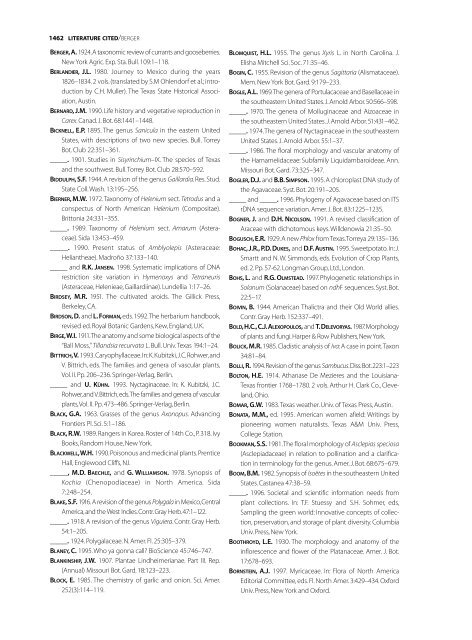References - Botanical Research Institute of Texas
References - Botanical Research Institute of Texas
References - Botanical Research Institute of Texas
You also want an ePaper? Increase the reach of your titles
YUMPU automatically turns print PDFs into web optimized ePapers that Google loves.
1462 LITERATURE CITED/BERGER<br />
BERGER,A.1924.A taxonomic review <strong>of</strong> currants and gooseberries.<br />
New York Agric. Exp. Sta. Bull. 109:1–118.<br />
BERLANDIER, J.L.1980. Journey to Mexico during the years<br />
1826–1834. 2 vols. (translated by S.M Ohlendorf et al.; introduction<br />
by C.H. Muller). The <strong>Texas</strong> State Historical Association,<br />
Austin.<br />
BERNARD,J.M.1990. Life history and vegetative reproduction in<br />
Carex.Canad. J. Bot. 68:1441–1448.<br />
BICKNELL, E.P.1895. The genus Sanicula in the eastern United<br />
States, with descriptions <strong>of</strong> two new species. Bull. Torrey<br />
Bot. Club 22:351–361.<br />
_____. 1901. Studies in Sisyrinchium–IX. The species <strong>of</strong> <strong>Texas</strong><br />
and the southwest. Bull.Torrey Bot. Club 28:570–592.<br />
BIDDULPH,S.F.1944. A revision <strong>of</strong> the genus Gaillardia.Res.Stud.<br />
State Coll.Wash. 13:195–256.<br />
BIERNER,M.W.1972.Taxonomy <strong>of</strong> Helenium sect. Tetrodus and a<br />
conspectus <strong>of</strong> North American Helenium (Compositae).<br />
Brittonia 24:331–355.<br />
_____. 1989. Taxonomy <strong>of</strong> Helenium sect. Amarum (Asteraceae).<br />
Sida 13:453–459.<br />
_____. 1990. Present status <strong>of</strong> Amblyolepis (Asteraceae:<br />
Heliantheae). Madroño 37:133–140.<br />
_____ and R.K. JANSEN. 1998. Systematic implications <strong>of</strong> DNA<br />
restriction site variation in Hymenoxys and Tetraneuris<br />
(Asteraceae, Helenieae, Gaillardiinae). Lundellia 1:17–26.<br />
BIRDSEY, M.R.1951. The cultivated aroids. The Gillick Press,<br />
Berkeley, CA.<br />
BIRDSON,D.and L. FORMAN,eds.1992.The herbarium handbook,<br />
revised ed. Royal Botanic Gardens, Kew, England, U.K.<br />
BIRGE,W.I. 1911.The anatomy and some biological aspects <strong>of</strong> the<br />
“Ball Moss,” Tillandsia recurvata L. Bull. Univ.<strong>Texas</strong> 194:1–24.<br />
BITTRICH,V. 1993.Caryophyllaceae.In:K.Kubitzki,J.C.Rohwer,and<br />
V. Bittrich, eds. The families and genera <strong>of</strong> vascular plants,<br />
Vol. II. Pp. 206–236. Springer-Verlag, Berlin.<br />
_____ and U. KÜHN. 1993. Nyctaginaceae. In: K. Kubitzki, J.C.<br />
Rohwer,and V.Bittrich,eds.The families and genera <strong>of</strong> vascular<br />
plants,Vol. II. Pp. 473–486. Springer-Verlag, Berlin.<br />
BLACK, G.A.1963. Grasses <strong>of</strong> the genus Axonopus. Advancing<br />
Frontiers Pl. Sci. 5:1–186.<br />
BLACK,R.W.1989. Rangers in Korea. Roster <strong>of</strong> 14th Co., P. 318. Ivy<br />
Books, Random House, New York.<br />
BLACKWELL,W.H. 1990.Poisonous and medicinal plants.Prentice<br />
Hall, Englewood Cliffs, NJ.<br />
_____, M.D. BAECHLE, and G. WILLIAMSON. 1978. Synopsis <strong>of</strong><br />
Kochia (Chenopodiaceae) in North America. Sida<br />
7:248–254.<br />
BLAKE,S.F.1916.A revision <strong>of</strong> the genus Polygala in Mexico,Central<br />
America, and the West Indies.Contr.Gray Herb.47:1–122.<br />
_____. 1918. A revision <strong>of</strong> the genus Viguiera.Contr.Gray Herb.<br />
54:1–205.<br />
_____. 1924. Polygalaceae. N. Amer. Fl. 25:305–379.<br />
BLANEY,C.1995.Who ya gonna call? BioScience 45:746–747.<br />
BLANKINSHIP, J.W.1907. Plantae Lindheimerianae. Part III. Rep.<br />
(Annual) Missouri Bot. Gard. 18:123–223.<br />
BLOCK, E.1985. The chemistry <strong>of</strong> garlic and onion. Sci. Amer.<br />
252(3):114–119.<br />
BLOMQUIST, H.L.1955. The genus Xyris L. in North Carolina. J.<br />
Elisha Mitchell Sci. Soc. 71:35–46.<br />
BOGIN,C.1955. Revision <strong>of</strong> the genus Sagittaria (Alismataceae).<br />
Mem. New York Bot. Gard. 9:179–233.<br />
BOGLE,A.L.1969.The genera <strong>of</strong> Portulacaceae and Basellaceae in<br />
the southeastern United States. J. Arnold Arbor. 50:566–598.<br />
_____. 1970. The genera <strong>of</strong> Molluginaceae and Aizoaceae in<br />
the southeastern United States.J.Arnold Arbor.51:431–462.<br />
_____. 1974.The genera <strong>of</strong> Nyctaginaceae in the southeastern<br />
United States. J. Arnold Arbor. 55:1–37.<br />
_____. 1986. The floral morphology and vascular anatomy <strong>of</strong><br />
the Hamamelidaceae: Subfamily Liquidambaroideae. Ann.<br />
Missouri Bot. Gard. 73:325–347.<br />
BOGLER,D.J.and B.B. SIMPSON. 1995.A chloroplast DNA study <strong>of</strong><br />
the Agavaceae. Syst. Bot. 20:191–205.<br />
_____ and _____. 1996. Phylogeny <strong>of</strong> Agavaceae based on ITS<br />
rDNA sequence variation. Amer. J. Bot. 83:1225–1235.<br />
BOGNER,J.and D.H. NICOLSON. 1991. A revised classification <strong>of</strong><br />
Araceae with dichotomous keys.Willdenowia 21:35–50.<br />
BOGUSCH,E.R.1929.A new Phlox from <strong>Texas</strong>.Torreya 29:135–136.<br />
BOHAC,J.R., P.D. DUKES, and D.F. AUSTIN. 1995. Sweetpotato. In: J.<br />
Smartt and N. W. Simmonds, eds. Evolution <strong>of</strong> Crop Plants,<br />
ed. 2. Pp. 57-62. Longman Group, Ltd., London.<br />
BOHS,L.and R.G. OLMSTEAD. 1997. Phylogenetic relationships in<br />
Solanum (Solanaceae) based on ndhF sequences. Syst. Bot.<br />
22:5–17.<br />
BOIVIN, B.1944. American Thalictra and their Old World allies.<br />
Contr. Gray Herb. 152:337–491.<br />
BOLD,H.C.,C.J.ALEXOPOULOS, and T. DELEVORYAS. 1987. Morphology<br />
<strong>of</strong> plants and fungi.Harper & Row Publishers, New York.<br />
BOLICK,M.R.1985. Cladistic analysis <strong>of</strong> Iva:A case in point.Taxon<br />
34:81–84.<br />
BOLLI,R.1994.Revision <strong>of</strong> the genus Sambucus.Diss.Bot.223:1–223<br />
BOLTON, H.E.1914. Athanase De Mezieres and the Louisiana-<br />
<strong>Texas</strong> frontier 1768–1780. 2 vols. Arthur H. Clark Co., Cleveland,<br />
Ohio.<br />
BOMAR,G.W.1983.<strong>Texas</strong> weather. Univ. <strong>of</strong> <strong>Texas</strong> Press, Austin.<br />
BONATA, M.M., ed. 1995. American women afield: Writings by<br />
pioneering women naturalists. <strong>Texas</strong> A&M Univ. Press,<br />
College Station.<br />
BOOKMAN,S.S.1981.The floral morphology <strong>of</strong> Asclepias speciosa<br />
(Asclepiadaceae) in relation to pollination and a clarification<br />
in terminology for the genus. Amer. J. Bot. 68:675–679.<br />
BOOM,B.M.1982.Synopsis <strong>of</strong> Isoëtes in the southeastern United<br />
States. Castanea 47:38–59.<br />
_____. 1996. Societal and scientific information needs from<br />
plant collections. In: T.F. Stuessy and S.H. Sohmer, eds,<br />
Sampling the green world: Innovative concepts <strong>of</strong> collection,<br />
preservation, and storage <strong>of</strong> plant diversity. Columbia<br />
Univ. Press, New York.<br />
BOOTHROYD, L.E.1930. The morphology and anatomy <strong>of</strong> the<br />
inflorescence and flower <strong>of</strong> the Platanaceae. Amer. J. Bot.<br />
17:678–693.<br />
BORNSTEIN, A.J.1997. Myricaceae. In: Flora <strong>of</strong> North America<br />
Editorial Committee, eds. Fl. North Amer. 3:429–434. Oxford<br />
Univ. Press, New York and Oxford.
















